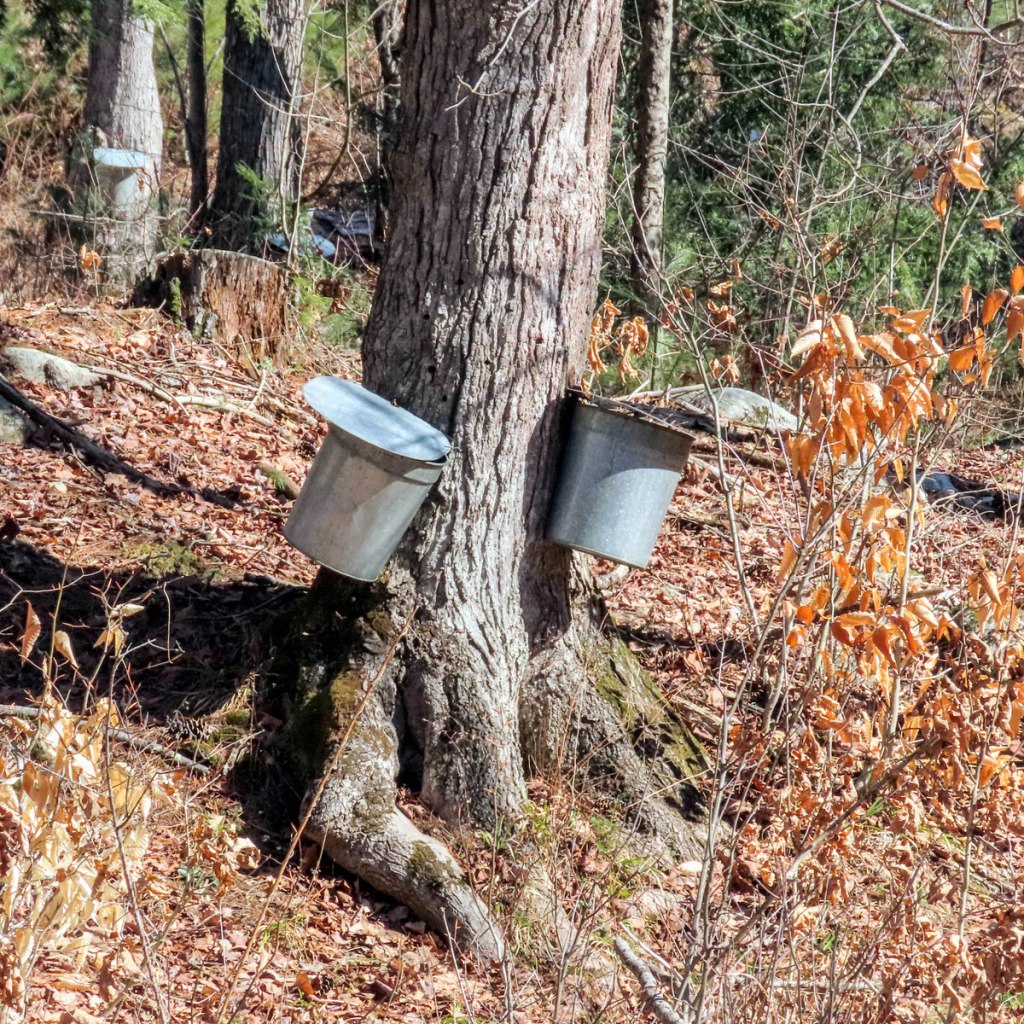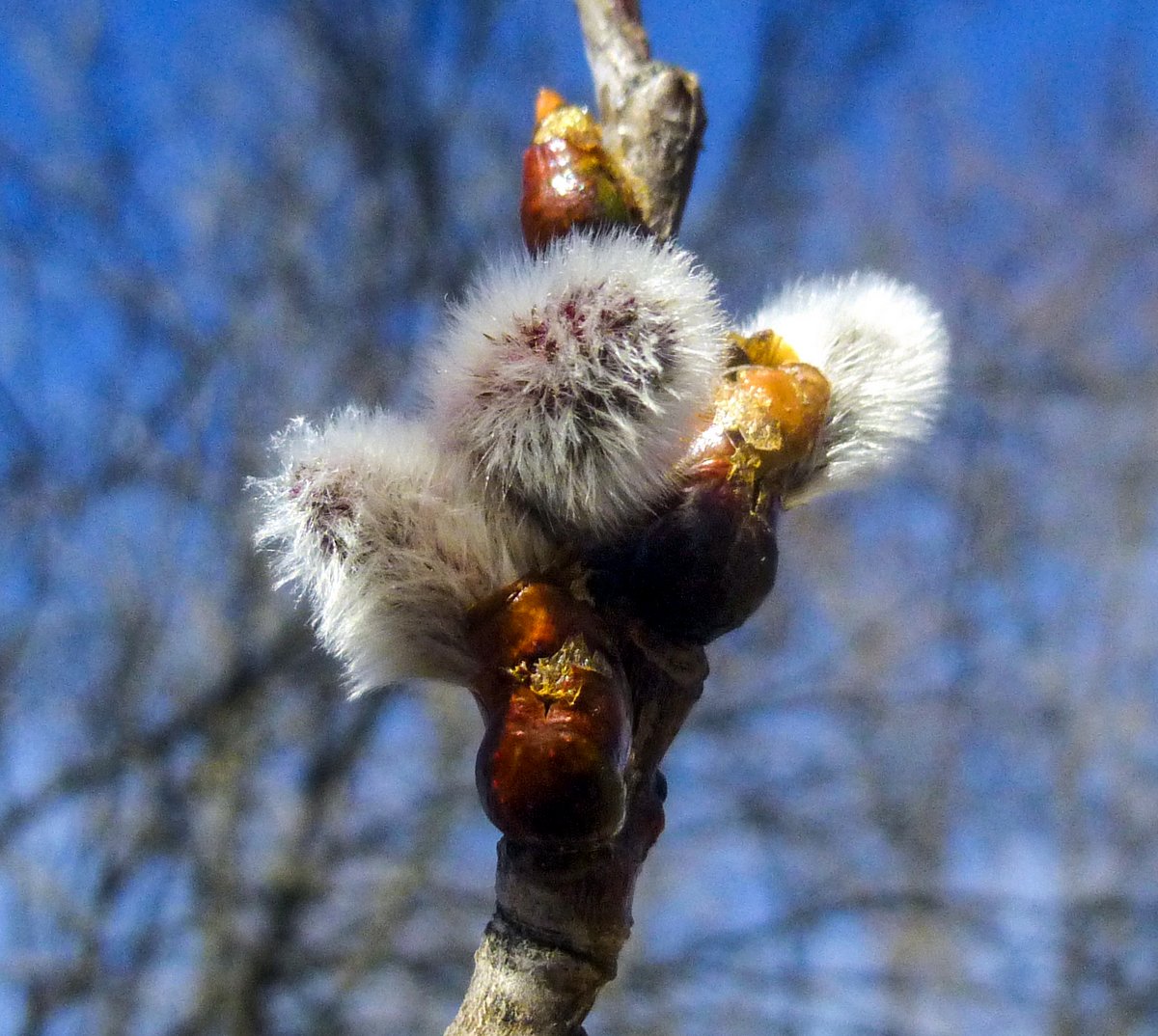
Spring is happening slowly again after a warm spell two weeks or so ago that got everything moving quickly. I saw maple sap flowing a couple of weeks ago but they just put out the sap buckets this past week. Warm days and cold nights are what keeps the sap flowing so hopefully it won’t get too hot too fast and spoil the season. Right now it’s just about right, with daytime temps in the 40s and nights getting down into the 20s. Much higher than the 40s during the daytime means the sap won’t run.

The red and silver maples are beautiful, loaded as they are with bright red buds.

I haven’t seen any maple flowers yet though, even though the buds are swelling. Maple trees can flower quickly and a tree that doesn’t have any flowers one day can be loaded with them the next. Maple syrup producers are in no hurry to see the trees flower because that means syrup season is just about done. Red maple sap especially, gets bitter once the trees start flowering, but luckily all the trees don’t blossom at the same time. Blossom times are naturally staggered so you can find trees just coming into flower as much as a month after you saw the first one blossom. Nature has it all figured out.

I looked at some of the beautiful powder blue box elder buds but they didn’t seem to be doing too much yet. They’re one of the last trees in the maple family to flower. The powdery blue color on the new twigs and buds is cause by the same natural wax like crystals that cause the bloom on blueberries, plums, and many other things. It’s there essentially to protect from sunburn.

I took that shot of the box elder branch at the river, where I also saw a large gathering of ducks and geese. This Canada goose was alone but there were also pairs there as well.

This is unusual. Ducks and geese don’t usually come onto the shore when there are people around. In fact they usually swim or fly to the other side of the river as soon as they see someone coming. It didn’t take long to see what had removed their fear though; someone had dumped something they liked on shore and they all wanted it. From a distance it looked like it might have been cracked corn but I couldn’t be sure. Every time Mr. and Mrs. Mallard got too close the geese would run them off, so it must have been tasty. Feeding wildfowl isn’t usually done here so I can’t even guess what this was all about.

After the mallards got the geese really bothered one goose stood guard while the other ate. You can see the mallards over there on the right, plotting their next move.

The waterfowl are happy the ice is gone but really, there wasn’t much to go. Nobody was able to skate on this pond at a local park this year and the annual ice fishing derby on Wilson Pond in Swanzey was cancelled because what little ice there was never got thick enough to support all the fishermen. This is the first time that has happened, I think.

I gave up on winter and went looking for spring, and I was glad I did. I found this grouping of crocus at the local college. A lady saw me with my camera and stopped me to ask if I was there to get photos of the locust. “The locust?” I asked. She must have thought I looked confused because she said “You know; the flowers.” I told her that I thought she might mean the crocus and if so yes, that was what I was there for. “Oh yes, locusts are insects, right?” “Yes, that’s right,” I replied. I didn’t want to explain that certain trees are also known as locusts. “Well, have fun,” she said with a smile, and off she went.

This one was my favorite.

The ones that are white inside and have three petals that are purple on the outside is another favorite. I think this is the first time I’ve ever found them wide open like this. For years I’ve always found them closed.

At another part of the college there are groups of yellow crocus planted with groups of purple ones. The yellow ones always seem to come up first and there are a lot of them blooming right now.

Bees were enjoying the flowers too.

I was surprised to see the bees because I didn’t think it had warmed up enough for them. They left these crocus flowers covered in pollen, so their timing was perfect.

I saw one or two purple crocuses but there are lots more to come. I always like to see the beautiful feathery designs inside these flowers.

I saw just one wrinkled viola blossom, which is odd. In years past these plants often bloomed before the crocuses, and it was colder then.

There are a few snowdrops in bloom with many more of them to come as well.

Dandelions started blooming two or three weeks ago and they haven’t stopped since. Not even snow can slow them down this year.

The Cornelian cherries are taking it slow. Like a child dipping one toe at a time in the water to feel its temperature, they seem to open one bud at a time to feel the air temperature. Then one day, as if a silent signal was given, you’ll walk by one of the trees and all its flowers will be open.

I don’t think I’ve ever seen the spring blooming witch hazels with so many flowers on them as they have this year. I stopped to see them one day and found bees all over them. The flowers seen here seemed to be what they preferred. Possibly because they’re the most fragrant. You can smell them from a block away when the breeze is right.

I like this one because of its long petals. On cold nights they roll up each of the four petals and tuck them in for the night. In the morning when the sun warms them they unroll them again. That’s why the petals always look so crinkly, almost like crepe paper. Other than to attract insects and look pretty, they serve no real purpose.
Go out in nature and you will find yourself in love with all of nature’s kind. ~Wald Wassermann
Thanks for coming by.














